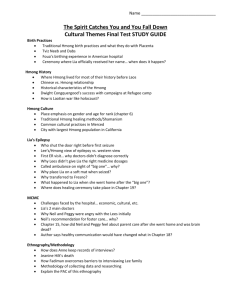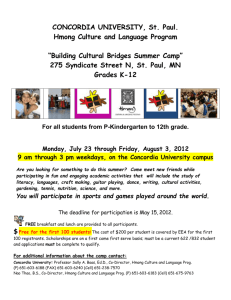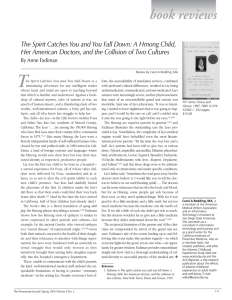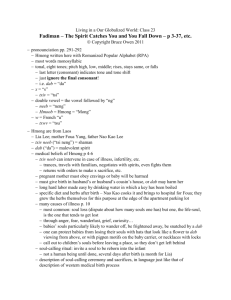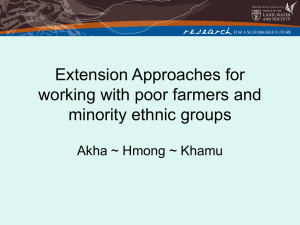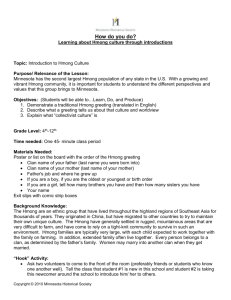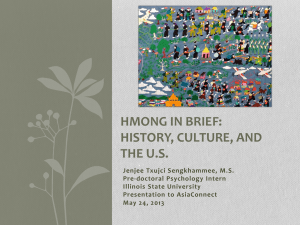view the pdf - Prized Writing
advertisement
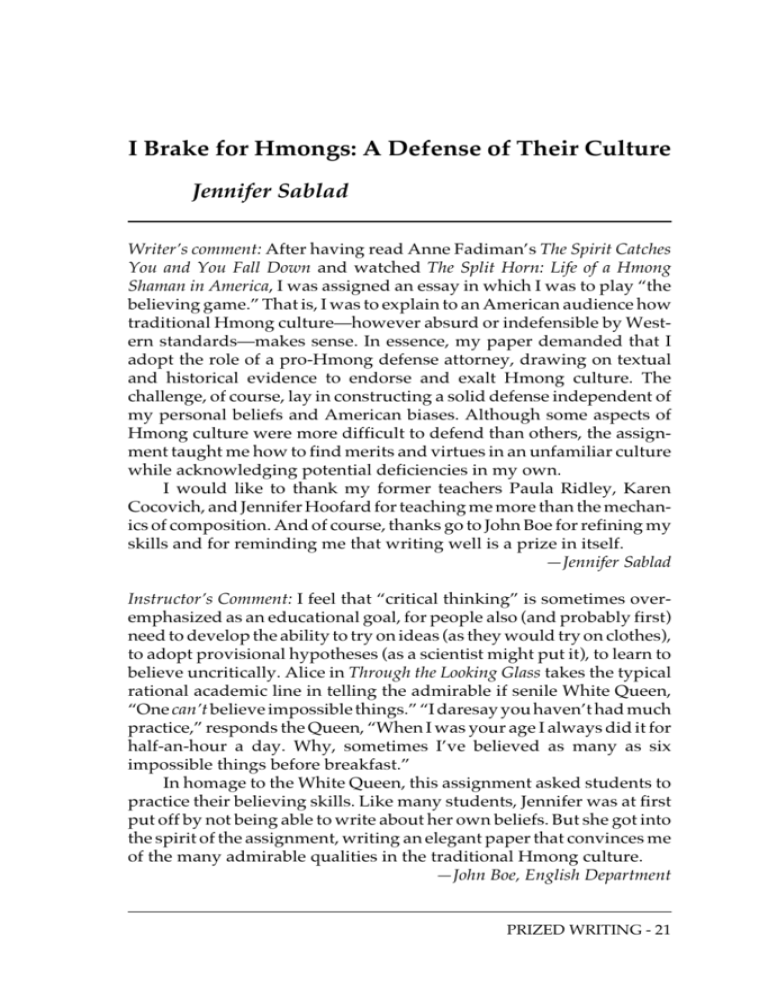
I Brake for Hmongs: A Defense of Their Culture Jennifer Sablad Writer’s comment: After having read Anne Fadiman’s The Spirit Catches You and You Fall Down and watched The Split Horn: Life of a Hmong Shaman in America, I was assigned an essay in which I was to play “the believing game.” That is, I was to explain to an American audience how traditional Hmong culture—however absurd or indefensible by Western standards—makes sense. In essence, my paper demanded that I adopt the role of a pro-Hmong defense attorney, drawing on textual and historical evidence to endorse and exalt Hmong culture. The challenge, of course, lay in constructing a solid defense independent of my personal beliefs and American biases. Although some aspects of Hmong culture were more difficult to defend than others, the assignment taught me how to find merits and virtues in an unfamiliar culture while acknowledging potential deficiencies in my own. I would like to thank my former teachers Paula Ridley, Karen Cocovich, and Jennifer Hoofard for teaching me more than the mechanics of composition. And of course, thanks go to John Boe for refining my skills and for reminding me that writing well is a prize in itself. —Jennifer Sablad Instructor’s Comment: I feel that “critical thinking” is sometimes overemphasized as an educational goal, for people also (and probably first) need to develop the ability to try on ideas (as they would try on clothes), to adopt provisional hypotheses (as a scientist might put it), to learn to believe uncritically. Alice in Through the Looking Glass takes the typical rational academic line in telling the admirable if senile White Queen, “One can’t believe impossible things.” “I daresay you haven’t had much practice,” responds the Queen, “When I was your age I always did it for half-an-hour a day. Why, sometimes I’ve believed as many as six impossible things before breakfast.” In homage to the White Queen, this assignment asked students to practice their believing skills. Like many students, Jennifer was at first put off by not being able to write about her own beliefs. But she got into the spirit of the assignment, writing an elegant paper that convinces me of the many admirable qualities in the traditional Hmong culture. —John Boe, English Department PRIZED WRITING - 21 JENNIFER SABLAD T O THE UNTRAINED EYE, the Hmong are a bizarrely foreign people. The stereotypes associated with Hmong communities—grue some animal sacrifices, a fear of evil spirits, and an adamant rejection of Western medicine—all construct an unfavorable first impression. But as I demystify these and other misunderstood aspects of Hmong culture, I urge you Americans to compare yourselves to the Hmong and decide which group is really worthy of emulation. Given a closer look, each “bizarre” facet of Hmong culture reflects rational thinking. Take for instance, the Hmongs’ sacrifice of pigs and cows to bolster the health of ill family members by warding off “dabs”— evil spirits capable of abducting a human soul, causing that person to become ill. Because many Americans consider this practice absurd and unnecessary, they fail to realize the underlying practicality of slaughtering an animal: the sheer expense of the creature (both financially and spiritually) sacralizes the event, while the remaining carcass effectively feeds dozens of well-wishing relatives. In addition to personally thanking the sacrificial pig or cow for offering its soul, the Hmong also utilize up to ninety-eight percent of the animal body, “intestines and everything, in a very ecologically sound way” (Fadiman 107). When compared to Americans, who consume a mere sixty percent of each slaughtered cow (Down to Earth), the Hmong display a more environmentally conscious, and therefore better, way to eat meat. While this ecological aspect of animal sacrifice is credible, perhaps you’re unconvinced of the spiritual aspect—that is, how can the Hmong believe in the existence and influence of dabs? Why, for the same reason Catholics like me acknowledge God’s intervention in human affairs. You see, religion is not about justifying your spiritual beliefs with science; it’s about accepting that there are forces in life beyond the narrow realm of logic. Think of all that science fails to explain: funny coincidences, prophetic dreams, why people fall in love. It’s phenomena like these that make us question the authority of science while opening our minds to the possibility of fate. To make it short, believing that fate plays a role—even a small one—in our future is analogous to the Hmongs’ belief that certain spirits play a role in theirs. Related to the topic of spirits is shamanism, another highly misunderstood yet fundamental aspect of Hmong culture. Because the Hmong attribute a person’s illness to the loss of his or her soul, they often solicit a shaman, or spiritual healer, to summon the soul back to the body, thereby restoring the person’s health. While many Americans view PRIZED WRITING - 22 I BRAKE FOR HMONGS shamanistic rituals as a primitive method of healing the sick, there have been numerous cases where intervention by shamans has successfully cured ailing patients. Take, for example, the surgeon friend of author Myron Eshowsky. The unnamed, yet world-renowned surgeon, had been unable to practice medicine for a year due to the development of a neuro-muscular disorder. Although the doctor followed a prescribed regimen of therapy and anti-anxiety medications, his symptoms persisted, leaving him distressed. Meanwhile, Eshowsky learned from a Hmong shaman in Wisconsin how to work with the “demons” that caused the doctor’s disease. Following the shaman’s technique, Eshowsky showed his ill surgeon friend how to “journey to the spirit of his conflict” and appease his “demon” with a shrine, complete with “daily food offerings and a song sung” (4). Just a few days after this ritual was performed, the doctor’s symptoms vanished and he immediately, and quite happily, resumed work in the operating room. The case of Myron Eshowsky’s doctor friend clearly demonstrates that Hmong shamanism is not only successful, but also capable of compensating for what Western medicine cannot and could not cure. Of course, no Hmong is immortal; yet the way the Hmong handle deaths and funerals makes it seem as though they are. Let me elaborate: when a Hmong dies, he or she is not simply buried, prayed for, and forgotten, as in a typical Christian funeral. Rather, Hmong families engage in elaborate four-day funeral ceremonies, as seen in The Split Horn, in which the deceased is dressed in a special embroidered coat and fed his favorite foods, while a family member plays an instrument called the qeej in order to lead the dead man’s soul back to the care of his ancestors. Amazingly, almost all family members actively participate in the funeral process, whether by preparing food, sacrificing chickens, or constructing umbrellas to provide shade at the man’s gravesite. Although the funeral itself is somber, the family members must band their efforts to conduct the ceremony perfectly so that the dead person’s soul will find eternal peace, lest it come back to haunt the family. The fact that the Hmong spend so much time and effort on giving their relatives proper burials is both honorable and saddening— honorable because they place so much emphasis on worshipping and remembering the dead; saddening because it makes an American like me realize her own lack of touch with her ancestors. As a perpetually busy American, I have never taken more than one day off to attend a funeral, nor have I experienced the comforting feeling of leaving food PRIZED WRITING - 23 JENNIFER SABLAD and little umbrellas for my departed relatives. Like many time-conscious Americans, I feel the societal pressure to mourn briefly and move on with my life. I can only wish that my own children will spend as much time on my funeral as the Hmong do on theirs, but I know the hectic demands of American life will make that impossible. That is what I meant when I said the Hmong are immortal; they revere their ancestors so devotedly that even the long dead are never truly forgotten. The love and reverence the Hmong have for the deceased, however, cannot rival the love and adoration they have for their children. Hmong parents are known for “the gentleness with which they treat their children,” frequently holding and coddling their young ones and even letting them sleep in the family bed (Fadiman 21). This regular physical contact between parent and child justifies the University of Minnesota finding that Hmong mothers are “more sensitive, more accepting, more responsive...and more ‘attuned’ to their children’s signals” than Caucasian mothers (Fadiman 22). Although some American parents are reluctant to baby their children for fear of prolonging their children’s dependence, they could stand to learn a few parenting skills from the Hmong: Foua and Nao Kao, who presumably nurtured all their children in typical Hmong fashion, raised a successful family of athletic, college-bound daughters and a proud, military-bound son. The Lee siblings represent Hmong school children in general, students who “rarely caused disciplinary problems and regularly crowded the honor rolls” (Fadiman 238). Although Foua and Nao Kao Lee could not understand what their kids studied in school or help them with homework, the extreme love they conveyed to their children over the years is apparent in True Lee’s statement to Anne Fadiman: “My parents are the coolest parents in the world. We don’t have everything in the world, but we do have the closeness of us eight sisters, one brother, and our parents. . . . I would never trade it for anything” (251). The fact that the Lee siblings (except Lia) grew into independent, well-adjusted adults defies the American notion that children must be physically separated from their parents—as in cribs and private bedrooms—in order to cultivate their independence. American parents are so preoccupied with fostering their children’s individualism that they often overlook the importance and simplicity of human touch: babies—more often than not—respond well to their fathers’ hugs and the soothing strokes of their mothers’ fingers on their foreheads. Learning to nurture children closely—the Hmong way—could only improve America’s future parents. PRIZED WRITING - 24 I BRAKE FOR HMONGS The Hmongs’ adoration of children in general, however, is not as admirable as their deeper love for disabled children like Lia, an epileptic. According to George M. Scott, Jr., in Laos “Even those [children] with physical or mental deformities were showered with affection, indeed with even greater affection than normal children” (Fadiman 215). Lia’s mother, Foua, indeed showers this same love on her braindead daughter: unlike the other “pasty-skinned, slack-mouthed, urinesmelling, vegetative patients” Fadiman had seen in hospitals, Lia was well-groomed with shiny black hair, fair skin, and pink lips (216). Even after Lia’s final, debilitating seizure, Foua still “cuddles, strokes, rocks, bounces, and sings to” her often expressionless daughter with plenty of motherly enthusiasm (217). Sadly, Foua’s self-appointed obligation to care for Lia is so extreme that she has no time to sew paj ntaub (Hmong for “flower cloth”) or visit places outside the Lee’s home—all because she “loves Lia too much” (218). The fact that Foua sacrifices her own freedom so that Lia will be well cared for should bring guilt to those American adults who liberally institutionalize their retarded children and senile parents. Whereas the Hmong hold the disabled and feeble close to their hearts, many Americans, busy with the events of their personal lives, pay caretakers to do it for them. Remarkably, the Hmongs’ unparalleled ability to love their children is not strained, but in fact strengthened, by the many challenges presented by their disabilities. Maintaining a close-knit family at any cost is also important to the Hmong. Unlike many Americans who are individualistic and secular, the Hmong work hard to ensure the survival of the entire family and not just a few select members. For instance, in the Thai refugee camps, Hmong parents “claimed their children were older than they really were so they could receive larger food allotments” (Fadiman 243). In the United States, they “told immigration officials that collateral relatives were members of their immediate families”—not only to avoid separation, but because it was “unethical—in fact, unpardonable—for them to leave their relatives behind” (Fadiman 243). Indeed, the Hmong understood the incredible value of keeping a solid, “supportive community in the larger and harsher world of America” (244). On a lesser scale, the Hmong group ethic enabled families like the Lees to pass driving tests, locate interpreters, find last minute rides to the hospital, and pool resources for Lia’s herbal amulets and sacrificial pigs. The Hmong tradition of putting the group before the self strongly echoes Jonas PRIZED WRITING - 25 JENNIFER SABLAD Vangay’s observation that in contrast to self-centered Americans, “For the Hmong, it is never everyone for himself” (Fadiman 247). The Hmong are a shining example of true ethnic solidarity. Given their turbulent history of migration and persecution by China, as well as the tragic loss of their home country to the Vietnam War, the Hmong have done exceedingly well in keeping their culture alive. In her years of experience, Fadiman herself can think of no other group of immigrants whose culture has been so little eroded by assimilation. Virtually all Hmong still marry other Hmong and have large families. . . . Clan and lineage structures [remain] intact. . . . Animal sacrifices are common. . . . Even more crucially, the essential Hmong temperament—independent, insular, antiauthoritarian, suspicious, stubborn, proud, choleric, energetic, vehement, loquacious, humorous, hospitable, generous— has so far been ineradicable. (208) With all the trauma the Hmong have suffered after fighting in the war—depression, anxiety, phobia, paranoia, and their unforgettable betrayal by the American government—the Hmong have every reason to break themselves down. But they don’t. In an equivalent span of time, the Hmong have experienced more warfare, witnessed more brutality, lost more family members, harbored more sorrow, and suffered more injustice than any American I have ever known. This collective historical identity of the Hmong unquestionably transcends my lowly American experience. I can only hope to infuse myself with the awesomeness of the Hmong spirit, but I’ve come to recognize that there is only one group of people on earth even worthy of emulating the Hmong: themselves. Works Cited Down to Earth Natural Foods and Lifestyle. “Recycling Cows, it’s even worse than it sounds...” <http://www.downtoearth.org>. Eshowsky, Myron. “Shamanism and Peacemaking.” The Foundation for Shamanistic Studies. <http://www.eren.doe.gov/RE/wind.html>. Fadiman, Anne. The Spirit Catches You and You Fall Down: A Hmong Child, Her American Doctors, and the Collision of Two Cultures. New York: Farrar, Straus, and Giroux, 1997. PRIZED WRITING - 26
